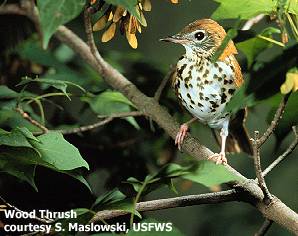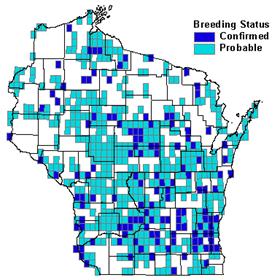

Status/Protection
- Global Rank: G5 Key to global and state ranks
- State Rank: S4B
- WBCI Priority: SGCN, PIF, State Special Concern
Population Information
The Federal BBS information can be obtained at http://www.mbr-pwrc.usgs.gov/bbs/bbs.html by clicking on Trend Estimates and selecting the species in question. All estimates are for time period (1966-2005).
- Federal Breeding Bird Survey: significant decline
- Federal Breeding Bird Survey (WI): non-significant increase
- Federal Breeding Bird Survey (BCR 23): non-significant increase
- Federal Breeding Bird Survey (BCR 12): significant decline
- Chequamegon National Forest Bird Survey (NRRI): stable (1992-2005)
- WSO Checklist Project: significant inverted u-shaped quadratic trend (1983-2007)
Life History
- Breeding Range: Southern Ontario south to Florida east to the Atlantic coast.
- Breeding Habitat: Central Hardwood, Oak, Northern Hardwood, Bottomland Hardwood.
- Nest: Cup, 0-6 meters above ground.
- Nesting Dates: Eggs: mid-May to late July (Robbins 1991).
- Foraging: Probing and gleaning at ground level (Ehrlich et al. 1988).
- Migrant Status: Neotropical migrant.
- Habitat use during Migration: Not well known, but assumed similar to breeding habitat.
- Arrival Dates: Late April to late May (Robbins 1991).
- Departure Dates: Mid-August to early October (Robbins 1991).
- Winter Range: Southern Mexico through Central America.
- Winter Habitat: Similar to breeding habitat, including interior of tropical forests.
Habitat Selection
The Wood Thrush is an icon and barometer of forest conservation in the eastern deciduous forests. It occurs mostly in upland, moist forests with large trees, diverse tree communities, moderate undergrowth, and ample leaf litter (Roth et al. 1996). In the Baraboo Hills region of Wisconsin, Mossman and Lange (1982) found it under well-formed forest canopies, with nests often in areas of semi-dense saplings 2-5 m tall. In Chequamegon National Forest, the Wood Thrush is most common in pole-sized sugar maple/basswood stands and paper birch stands (Danz et al. 2007). In areas of sympatry with Veery, the Wood Thrush prefers more mature forests with more canopy cover, fewer shrubs, and more leaf litter (Roth et al. 1996); in the Baraboo Hills, it selected drier sites (Mossman and Lange 1982).
Although Wood Thrushes are considered to be area sensitive (Roth et al. 1996), the amount of core habitat within 5 km of a nest may be a better predictor of nest success than the amount of total forest cover (Driscoll et al. 2005). Nests are placed in the lower canopy or undergrowth, typically nestled in a crotch or saddled over a horizontal branch (Roth et al. 1996). In Wisconsin, Mossman and Lange (1982) found nests at heights of 1.6-9 m in upright forks of saplings, most commonly sugar maple, ironwood, or witch-hazel. Habitats used during migration and winter are similar to breeding habitats, but less studied. In winter it is found primarily in forest interiors (Roth et al. 1996) and typically avoids agricultural habitats and plantations (Robbins et al. 1992).
Habitat Availability
Historically, the Wood Thrush was common in the southern and central regions of Wisconsin. During the twentieth century, this species expanded its range northward in the state and larger region as northern forests recovered from turn-of-the-century logging and the prevalence of hardwoods increased (Roberts 1936:122-123, Dilger 1956:176, Robbins 1991). The Wood Thrush can be expected in large, unfragmented tracts of hardwood forest, which are becoming increasingly scarce in southern Wisconsin. Historical Wood Thrush habitat in this region has been drastically reduced by agricultural and urban development. Of the remaining forests, current forest management practices, grazing, and invasive species have resulted in changes to forest composition and structure that are not always amenable to the Wood Thrush’s habitat requirements (WDNR 2005). In northern Wisconsin suitable habitat remains extensive, though fragmentation is still a concern in some areas.
Population Concerns
Breeding Bird Survey (BBS) data for Wood Thrush suggest a range-wide decline and a stable trend in Wisconsin (Sauer et al. 2005). During the Wisconsin Breeding Bird Atlas (1995-2000), observers were able to confirm breeding on 12% of the surveyed quads (Lesher 2006). Fragmentation and consequent nest predation and brood parasitism may be contributing to the range-wide decline. In Wisconsin, Minnesota, and Missouri, Donovan et al. (1995) found parasitism caused 22-32% of all nest mortality in fragmented forests, but 0% in predominantly forested landscapes. In small woodlots in central Illinois, Robinson (1992) found 82% of nests were depredated and 100% were parasitized. In highly fragmented woodlots in mostly agricultural northern Indiana, Fauth (2000) found 58% of nests depredated and 90% parasitized; both rates were independent of fragment size and the overall landscape of the region was considered a population sink. Tropical deforestation on the wintering grounds also is cause for concern (Morton 1992, Roth et al. 1996).
Recommended Management
Management efforts for this species should focus on maintaining large blocks of unfragmented hardwood forests with scattered canopy gaps and patches of dense saplings. Reducing forest fragmentation by increasing forest patch size, increasing the proportion of interior to edge, and avoiding the placement of clearcuts in the immediate vicinity of stands with high conservation value or restoration potential also is warranted (WDNR 2005). Managers should focus more on providing unfragmented core habitat (Driscoll et al. 2005) as well as regional forest cover. Prescribed fire may temporarily reduce feeding and nesting substrates (i.e., leaf litter, midstory vegetation), but does not appear to have adverse consequences on reproductive success, at least when small patches within a forest remain unburned (Artman and Downhower 2003). Conservation and management strategies for this species should be focused in the following Wisconsin ecological landscapes: Central Lake Michigan Coastal, Central Sand Hills, Central Sand Plains, Forest Transition, North Central Forest, Northern Lake Michigan Coastal, Southeast Glacial Plains, Southern Lake Michigan Coastal, Western Coulee and Ridges, and Western Prairie (WDNR 2005).
Research Needs
More research on the habitat features associated with reproductive success is needed to manage critical habitat for Wood Thrush populations. Studies investigating the wintering areas of specific breeding populations are warranted (Roth et al. 2001). In Wisconsin, careful monitoring of the species is needed, as are studies on habitat use during migration, competition with other forest songbirds, and testing of various stand- and landscape-level management plans.
Information Sources
- Audubon WatchList: http://audubon2.org/webapp/watchlist/viewSpecies.jsp?id=222
- Birds of Forested Landscapes, Cornell Lab of Ornithology: http://birds.cornell.edu/bfl/speciesaccts/woothr.html
- Bird Conservation Western Great Lakes Basin: http://www.uwgb.edu/birds/greatlakes/species/woth.htm
- Chequamegon National Forest Bird Survey (NRRI) species account: http://www.nrri.umn.edu/mnbirds/accounts/WOTHa2.htm
- Nicolet National Forest Bird survey map: http://www.uwgb.edu/birds/nnf/species/WOTH.htm
- North American Breeding Bird Survey: http://www.mbr-pwrc.usgs.gov/bbs/bbs.html
- Patuxent Bird Identification Center: http://www.mbr-pwrc.usgs.gov/id/framlst/i7550id.html
- Temple S.A., J.R. Cary, and R. Rolley. 1997. Wisconsin Birds: A Seasonal and Geographical Guide. Wisconsin Society of Ornithology and Wisconsin Department of Natural Resources, Madison, WI.
- Wisconsin Breeding Bird Atlas: http://www.uwgb.edu/birds/wbba/
References
- Artman, V.L., J.F. Downhower, and F.R. Moore. 2003. Wood Thrush (Hylocichla mustelina) nesting ecology in relation to prescribed burning of mixed-oak forest in Ohio. Auk 120(3): 874-882.
- Bond, R.R. 1957. Ecological distribution of breeding birds in the upland forest of southern Wisconsin. Ecol. Monogr. 27(4): 351-384.
- Danz, N.P., G.J. Niemi, J. Lind, and J.M. Hanowski. 2007. Birds of Western Great Lakes Forests. www.nrri.umn.edu/mnbirds/
- Dilger, W.C. 1956. Adaptive modifications and ecological isolating mechanisms in the thrush genera Catharus and Hylocichl. Wilson Bulletin 68:171-199.
- Donovan, T.M., F.T. Thompson, and J. Faaborg. 1995. Reproductive success of migratory birds in habitat sources and sinks. Conserv. Biol. 9: 1380-1395.
- Driscoll, M.L., T. Donovan, R. Mickey, A. Howard, and K.K Fleming. 2005. Determinants of wood thrush nest success: a multi-scale, model selection approach. Journal of Wildlife Management 69(2): 699-709.
- Fauth, P.T. 2000. Reproductive success of Wood Thrushes in forest fragments in northern Indiana. Auk 117(1): 194-204.
- Lesher, F. 2006. Wood Thrush. In The Wisconsin Breeding Bird Atlas (N.J. Cutright, B.R Harriman, R.W Howe, eds.) The University of Wisconsin Press: Madison, WI.
- Morton, E. S. 1992. What do we know about the future of migrant landbirds. Pp. 579-589 In: Hagan, J. M. III, and D. W. Johnston [eds.]. Ecology and conservation of Neotropical migrant landbirds. Smithson. Inst. Press, Washington, D.C.
- Mossman, M.J., and K.I. Lange. 1982. Breeding birds of the Baraboo Hills, Wisconsin: Their history, distribution and ecology. Wis. Dep. Nat. Resour. and Wis. Soc. Ornithol., Madison.
- Robbins, S. D., Jr. 1991. Wisconsin birdlife: Population and distribution past and present. Madison, WI: Univ. Wisconsin Press.
- Robbins, C.S., B.A. Dowell, D.K. Dawson, J.A. Colon, R. Estrada, A. Sutton, R. Sutton, and D. Weyer. 1992. Comparison of Neotropical migrant landbird populations wintering in tropical forest, isolated fragments, and agricultural habitats. Pp 207-210 In: Hagan, J. M. III, and D. W. Johnston [eds.]. Ecology and conservation of Neotropical migrant landbirds. Smithson. Inst. Press, Washington, D.C.
- Robets, T.S. 1936. The Birds of Minnesota. Vol 2. University of Minnesota Press, Minneapolis.
- Robinson, S.K. 1992. Population dynamics of breeding Neotropical migrants in a fragmented Illinois landscape. Pp. 408-418 In: Hagan, J. M. III, and D. W. Johnston [eds.]. Ecology and conservation of Neotropical migrant landbirds. Smithson. Inst. Press, Washington, D.C.
- Roth, R.R., M.S. Johnson, and T.J. Underwood. 1996. Wood Thrush. In The Birds of North America, No. 246 (A. Poole and F. Gill, eds.). The Birds of North America, Inc., Philadelphia, PA.
- Sauer, J.R., J.E. Hines, and J. Fallon. 2005. The North American Breeding Bird Survey, Results and Analysis 1966 - 2005. Version 6.2.2006. USGS Patuxent Wildlife Research Center, Laurel, MD.
- Wisconsin Department of Natural Resources (WDNR). 2005. Wisconsin’s Strategy for Wildlife Species of Greatest Conservation Need. Madison, WI.
Contact Information
- Compiler: Tom Klubertanz, tklubert@uwc.edu
- Editor: Kim Kreitinger, K.Kreitinger@gmail.com | Mike Mossman, Michael.Mossman@Wisconsin.gov
